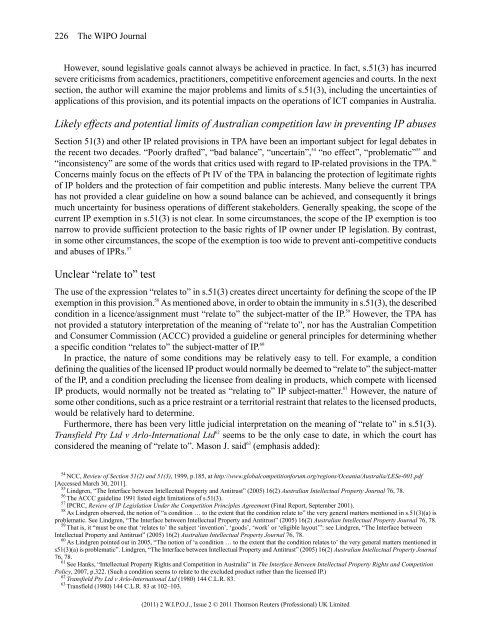WIPO Journal - World Intellectual Property Organization
WIPO Journal - World Intellectual Property Organization
WIPO Journal - World Intellectual Property Organization
Create successful ePaper yourself
Turn your PDF publications into a flip-book with our unique Google optimized e-Paper software.
226 The <strong>WIPO</strong> <strong>Journal</strong><br />
However, sound legislative goals cannot always be achieved in practice. In fact, s.51(3) has incurred<br />
severe criticisms from academics, practitioners, competitive enforcement agencies and courts. In the next<br />
section, the author will examine the major problems and limits of s.51(3), including the uncertainties of<br />
applications of this provision, and its potential impacts on the operations of ICT companies in Australia.<br />
Likely effects and potential limits of Australian competition law in preventing IP abuses<br />
Section 51(3) and other IP related provisions in TPA have been an important subject for legal debates in<br />
the recent two decades. “Poorly drafted”, “bad balance”, “uncertain”, 54 “no effect”, “problematic” 55 and<br />
“inconsistency” are some of the words that critics used with regard to IP-related provisions in the TPA. 56<br />
Concerns mainly focus on the effects of Pt IV of the TPA in balancing the protection of legitimate rights<br />
of IP holders and the protection of fair competition and public interests. Many believe the current TPA<br />
has not provided a clear guideline on how a sound balance can be achieved, and consequently it brings<br />
much uncertainty for business operations of different stakeholders. Generally speaking, the scope of the<br />
current IP exemption in s.51(3) is not clear. In some circumstances, the scope of the IP exemption is too<br />
narrow to provide sufficient protection to the basic rights of IP owner under IP legislation. By contrast,<br />
in some other circumstances, the scope of the exemption is too wide to prevent anti-competitive conducts<br />
and abuses of IPRs. 57<br />
Unclear “relate to” test<br />
The use of the expression “relates to” in s.51(3) creates direct uncertainty for defining the scope of the IP<br />
exemption in this provision. 58 As mentioned above, in order to obtain the immunity in s.51(3), the described<br />
condition in a licence/assignment must “relate to” the subject-matter of the IP. 59 However, the TPA has<br />
not provided a statutory interpretation of the meaning of “relate to”, nor has the Australian Competition<br />
and Consumer Commission (ACCC) provided a guideline or general principles for determining whether<br />
a specific condition “relates to” the subject-matter of IP. 60<br />
In practice, the nature of some conditions may be relatively easy to tell. For example, a condition<br />
defining the qualities of the licensed IP product would normally be deemed to “relate to” the subject-matter<br />
of the IP, and a condition precluding the licensee from dealing in products, which compete with licensed<br />
IP products, would normally not be treated as “relating to” IP subject-matter. 61 However, the nature of<br />
some other conditions, such as a price restraint or a territorial restraint that relates to the licensed products,<br />
would be relatively hard to determine.<br />
Furthermore, there has been very little judicial interpretation on the meaning of “relate to” in s.51(3).<br />
Transfield Pty Ltd v Arlo-International Ltd 62 seems to be the only case to date, in which the court has<br />
considered the meaning of “relate to”. Mason J. said 63 (emphasis added):<br />
54<br />
NCC, Review of Section 51(2) and 51(3), 1999, p.185, at http://www.globalcompetitionforum.org/regions/Oceania/Australia/LESe-001.pdf<br />
[Accessed March 30, 2011].<br />
55<br />
Lindgren, “The Interface between <strong>Intellectual</strong> <strong>Property</strong> and Antitrust” (2005) 16(2) Australian <strong>Intellectual</strong> <strong>Property</strong> <strong>Journal</strong> 76, 78.<br />
56<br />
The ACCC guideline 1991 listed eight limitations of s.51(3).<br />
57<br />
IPCRC, Review of IP Legislation Under the Competition Principles Agreement (Final Report, September 2001).<br />
58<br />
As Lindgren observed, the notion of “a condition … to the extent that the condition relate to” the very general matters mentioned in s.51(3)(a) is<br />
problematic. See Lindgren, “The Interface between <strong>Intellectual</strong> <strong>Property</strong> and Antitrust” (2005) 16(2) Australian <strong>Intellectual</strong> <strong>Property</strong> <strong>Journal</strong> 76, 78.<br />
59<br />
That is, it “must be one that ‘relates to’ the subject ‘invention’, ‘goods’, ‘work’ or ‘eligible layout’”: see Lindgren, “The Interface between<br />
<strong>Intellectual</strong> <strong>Property</strong> and Antitrust” (2005) 16(2) Australian <strong>Intellectual</strong> <strong>Property</strong> <strong>Journal</strong> 76, 78.<br />
60<br />
As Lindgren pointed out in 2005, “The notion of ‘a condition … to the extent that the condition relates to’ the very general matters mentioned in<br />
s51(3)(a) is problematic”. Lindgren, “The Interface between <strong>Intellectual</strong> <strong>Property</strong> and Antitrust” (2005) 16(2) Australian <strong>Intellectual</strong> <strong>Property</strong> <strong>Journal</strong><br />
76, 78.<br />
61<br />
See Hanks, “<strong>Intellectual</strong> <strong>Property</strong> Rights and Competition in Australia” in The Interface Between <strong>Intellectual</strong> <strong>Property</strong> Rights and Competition<br />
Policy, 2007, p.322. (Such a condition seems to relate to the excluded product rather than the licensed IP.)<br />
62<br />
Transfield Pty Ltd v Arlo-International Ltd (1980) 144 C.L.R. 83.<br />
63 Transfield (1980) 144 C.L.R. 83 at 102–103.<br />
(2011) 2 W.I.P.O.J., Issue 2 © 2011 Thomson Reuters (Professional) UK Limited

















